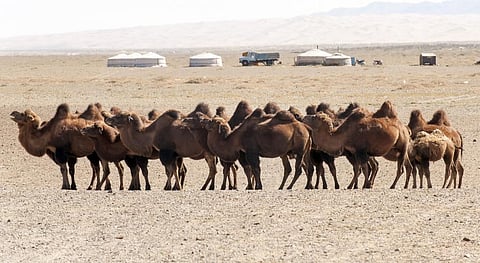

Camelids, or members of the camel family, are humanity’s true allies in combating desertification, Director-General of the United Nations Food and Agriculture Organization (FAO) QU Dongyu said in Rome on June 11, 2024.
Qu also called Bactrian camels, dromedaries, alpacas, guanacos, llamas, and vicuñas ‘true heroes of resilience’ as they support millions of people in building their own resilience to the impacts of the climate crisis in mountains and drylands, according to a statement by FAO.
The FAO leader was speaking after inaugurating an exhibition hosted by Saudi Arabia, which showcased the evolution of the camelid sector in the country.
The desert kingdom, along with Bolivia in South America, has been the main supporter of the UN campaign to globally observe 2024 as the International Year of Camelids.
Saudi Arabia has itself declared 2024 as the ‘Year of the Camel’ and its capital Riyadh will host the 16th Conference of the Parties to the UN Convention on Combating Desertification in December.
Interestingly, the Saudi Ministry of Culture also introduced “a camel studies grant” earlier this week. It is “an initiative designed to highlight the essential role camels play in Saudi Arabia’s cultural, social, and economic spheres through rigorous scientific research”, Arab News said, quoting the Saudi Press Agency.
Camelids evolved around 40 million years ago in North America, according to one study. Today, they are found in South America, Africa and Asia.
While alpacas, guanacos, llamas, and vicuñas are New World camelids, Asia (including India and Pakistan) and Africa are home to dromedaries. Asia also is home to Bactrian camels, which are found in Ladakh’s Nubra Valley.
“The International Year of Camelids 2024 highlights how camelids are key to the livelihoods of millions of households in difficult environments across over 90 countries, particularly Indigenous Peoples and local communities,” the FAO website notes.
Through extreme climatic conditions, camelids continue to provide products, food, organic fertilizer and transport to local communities and Indigenous Peoples, it adds.
“The camelid sector has untapped potential to help advance global efforts to achieve the 2030 Agenda for Sustainable Development and plays a key role in FAO’s sustainable livestock transformation framework in support of more efficient, more inclusive, more resilient and more sustainable agrifood systems, for better production, better nutrition, a better environment and a better life, leaving no one behind,” Qu stated at the event.